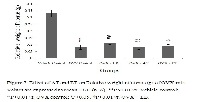Comparative Effect of Atorvastatin and Trigonella foenum graecum L. Seeds in the Postmenopausal Hyperlipidemia
Keywords:
Postmenopausal hyperlipidemia, ovariectomy, phytoestrogensAbstract
Trigonella foenum graecum L. (Fabaceae) seeds have been extensively used in Ayurveda and Unani medicine. It has been used as a traditional medicine for a household remedy against various human ailments. The seeds have been shown to possess hypoglycemic, hypocholesterolaemic and antioxidant activity. The present study is to evaluate whether ovariectomised (OVX) Wistar rats could form an experimental model of postmenopausal hyperlipidemia and to evaluate the antihyperlipidemic potential of Atorvastatin (AT) and Ethyl acetate extract of Trigonella foenum graecum L. Seeds (ET) in OVX Wistar rats and toxicity associated with it. Ovariectomy was performed to mimic the postmenopausal hyperlipidemic condition in Wistar rats. The effects of AT and ET on body weight, weight of uterus and the levels of total cholesterol (TC), triglycerides (TG), high density lipoproteins (HDL), low density lipoproteins (LDL), very low density lipoprotein (VLDL) were also evaluated. The rats in OVX control group showed 51% weight gain when compared with vehicle control group. The serum TC, TG, LDL, VLDL of OVX control group was found to be increased significantly; serum HDL level was reduced and atrophy of uterus was observed in comparison with vehicle control group. The ET showed the significant (P<0.05, P<0.01) antihyperlipidemic potency when compared with AT & proportional antihyperlipidemic potency in comparison with Estradiol benzoate (EB). These findings confirm the bilateral OVX Wistar rats as a model of postmenopausal hypercholesterolemia. The significant antihyperlipidemic activity of ET thus lends pharmacological credence to the suggested use of the plant as a safe natural remedy in the treatment of postmenopausal hyperlipidemia.
References
. Bolego C. Phytoestrogens:
pharmacological and therapeutic
perspectives. Curr Drug Targets. 2003;
:77-87.
. Chlebowski RT. Influence of estrogen
plus progestin on breast cancer and
mammography in healthy
postmenopausal women: the WomenÊs
Health Initiative Randomized Trial.
JAMA, 2003; 289:3243-3253.
. Fontana A, Delmas PD. Selective
estrogen receptors modulators in the
prevention and treatment of
postmenopausal osteoporosis.
Endocrinol Metab Clin North Am,
;32: 219-232.
. Gopumadhavan S. Uterotrophic effect
of Menotab (M-3119): A Preclinical
Study. Indian Journal of Pharmacology,
;34:237-243.
. Hu JY, Aizawa T. Quantitative
structure-activity relationships for
estrogen receptor binding affinity of
phenolic chemicals. Water Res,
;37:1213-1222.
. Johnson R. Use of the Friedewald
Formula to Estimate LDL-Cholesterol in
Patients with Chronic Renal Failure on
Dialysis. Clinical Chemistry, 1997;
:2183-2184.
. Khandelwal KR. Phytochemical
evaluation. In: Practical
Pharmacognosy Techniques and
Experiments. Pune, India: Nirali
Prakashan. 2004.
. Kummer V. Estrogenic effect of
Silymarin in ovariectomized rats. Vet.
MedăCzech, 2001;46(1) 17-23.
. Maturana MA, Irigoyen MC, Spritzer
PM. Menopause, estrogens, and
endothelial dysfunction: current
concepts. Clinics, 2007;62(1) 77-86.
. OECD. OECD NĈ „Acute Oral Toxicity -
Acute Toxic Class Method‰, The
Organization for Economic Cooperation and Development (OECD)
Guidelines for the Testing of
Chemicals, adopted by the Council on
December 423. 17, 2001.
. OECD. OECD NĈ „Uterotrophic
Bioassay in Rodents: A short-term
screening test for oestrogenic
properties‰, The Organization for
Economic Co-operation and
Development (OECD) Guidelines for
the Testing of Chemicals, adopted by
the Council on October 2007;440, 16.
. Olfa B. Lipid-Lowering and Antioxidant
Effects of an Ethyl Acetate Extract of
Fenugreek Seeds in High-CholesterolFed Rats. J. Agric. Food Chem.,
;58 (4) 2116ă2122.
. Shinoda M, Latour MG, Lavoie JM.
Effects of physical training on body
composition and organ weights in
ovariectomized and hyper estrogenic
rats. International Journal of Obesity,
;26:335ă343.
. Sreeja S. In vitro estrogenic activities of
fenugreek Trigonella foenum graecum
seeds. Indian J Med Res,
;131:814-819.
. Stark A, Madar Z. Phytoestrogens: a
review of recent findings. J Pediatr
Endocrinol Metab, 2002;15: 561-572.
. U.S. Department of Health and Human
Services. Facts about Menopausal
Hormone Therapy. NIH Publication No.
; 05-5200.
. Wang JF. Effects of Radix Puerariae
flavones on liver lipid metabolism in
ovariectomized rats. World J
Gastroenterol. 2004;10(13) 1967-1970.
. Wierzbicki AS. Atorvastatin - Expert
openion. Pharmacother, 2001; 2:819.
. Wilcox LJ, Borradaile N, Kurowska E,
Telford DE, Huff MW. Naringenin, a
citrus flavonoid, markedly decreases
apoB secretion in HepG2 cells and
inhibits Acyl CoA: cholesterol
acyltransferase. Circulation, 1998;98
ă537.



